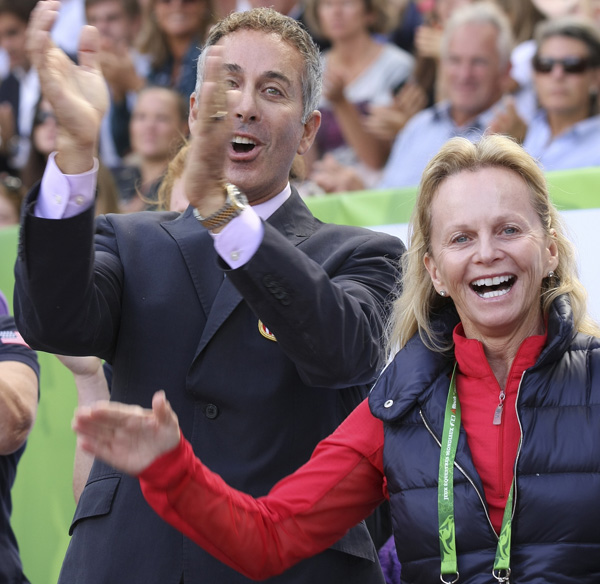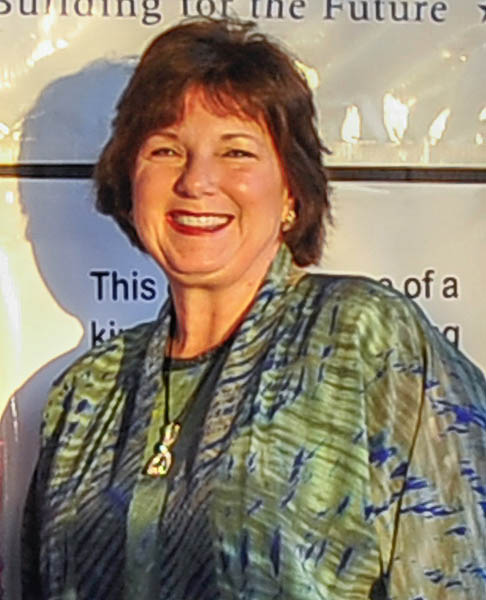Is America’s Eight-Year Absence from Dressage Medals Podium Coming to an End?
10 years ago StraightArrow Comments Off on Is America’s Eight-Year Absence from Dressage Medals Podium Coming to an End?

By KENNETH J. BRADDICK
CAEN, France, Aug. 31–An Olympic and world championship medalist and a rookie with only seven international Grand Prix to her credit may lead an America back to a place on the medals podium and a boost for the sport outside Europe.
The future hopes are in the hands of Steffen Peters, among the top riders in the world for a decade on the now-retired Ravel and more recently Legolas with a young star, Rosamunde, in the wings, and Laura Graves whose performances on her Verdades culminated in her becoming fifth in the Grand Prix Freestyle at the just completed World Games dressage, and combinations yet to prove out.
The results of the two have given credence to the promises of Robert Dover, the six-time Olympian and for the past 16 months leader of high performance dressage as U.S. Equestrian Federation Technical Advisor/Chef d’Equipe. His promise of getting America back on the medals podium seems more realistic after the team placed fourth at the WEG in Normandy last week.
And it appears to give credibility to Robert’s extraordinary move to adopt the role of fundraiser in chief in addition to his other duties to put as many American combinations as possible in front of judges in Europe so they could not be ignored as unknows when they made it to the championships.

The Normandy result was the best ever for a U.S. World Games team.
Steffen of San Diego, California on Legolas posted 75.843 per cent, Laura of Geneva, Florida on Verdades were at 74.871 per cent and Adrienne Lyle of Ketchum, Idaho on Wizard at 72.000 per cent for a total of 222.714. Only three scores count so the result of Tina Konyot of Palm City, Florida on Calecto V was dropped.
Although the team did not medal, the total eclipsed the previous best set at the 2002 WEG when the squad of Debbie McDonald on Brentina, Lisa Wilcox on Relevant and Sue Blinks on Flim Flam logged 221.08 to win the silver medal.
United States teams went on to win bronze at the 2004 Athens Olympics and the 2006 WEG in Aachen, Germany.
At the 2008 Olympics, one of the three combinations on the team was disqualified when a banned substance was found on a horse thus eliminating the team. At the 2010 World Games in Kentucky two individual bronze medal rides by Steffen and Ravel did not translate into any metal for the team, and 2012 was a drought for both team and individuals.

During this winter’s CDI circuits in Florida and California which were needed to get to the national championships where riders and horses could be among eight combinations to go to Europe to fight for a place on the WEG team, the roster of prospects looked slim.
Aside from Steffen and the 12-year-old Westfalen gelding the prime team prospets were the veterans from the 2012 Olympics–Calecto, Wizard and Jan Ebeling and Rafalca.
Laura and her 12-year-old KWPN gelding were only a blip on the radar, having won the Intermediate 2 at the inaugural U.S. Dressge Festival finals in late 2013. In three shows on the intensely competitive Florida circuit, scores ranged from mid-60 per cent to near 70 per cent, not enough to qualify for the selection trials. A quick trip to a Kentucky CDI3* in May and some of the 15 riders that had qualified pulling out gave Laura a foot in the door.
She and the horse her mother had bought as a foal from a sales video from Holland barged in to the inner circle, finishing second to Steffen and Legolas in the national championships.
They were on their way to Europe–better known from media exposure but never having competed before in Europe, the 27-year-old and Verdades looked like “a prospect,” that dreaded expression meaning not yet there.

Robert and the team were not intimidated by a German squad of three potential 80 per cent combinations even without Totilas, a Dutch squad of Edward Gal and Glock’s Undercover, though that horse too had to be swapped out forthe less talented Voice, and Adelinde Cornelissen and Jerich Parzival, and Great Britain’s world record holders Charlotte Dujardin and Valegro.
“Most people around the world thought America would land no better than sixth and more likely seventh or eighth as a team in Cean,” Robert told dressage-news.com.
“However, I knew that our athletes, both two- and four-legged, were feeling greater confidence with each European competition they took part in and continued to have personal bests at.”
By the time WEG started, Laura and Verdades had competed at Fritzens, Austria and Aachen, Germany, their scores climbing to mid-70 per cent. An unexpected glitch was the severe pneumonia that kept Steffen out of Aachen. He and Legolas recovered enough to compete a couple of weeks later at Verden, Germany as did the youngest rider at age 25, Caroline Roffman and Her Highness O. The result was sub-par but Verden was not a qualifier and their results from the selection trials, Fritzens and Aachen gave Caroline confidence they would be named to the team.
They were not, dropped in favor of Adrienne and Wizard and causing the first public display of dissension. Caroline did not disagree with the right of Robert and the selectors to choose the best team, just the way it was handled.

“The ongoing preparedness of each combination to help the U.S. successfully contend for medals was an integral part of our selection criteria and was rightfully a determining factor in the selection of the team,” was Robert’s view now the championships are over.
“I am 100 per cent confident that the selectors and the federation sent the best team suited for the WEG. I hope that all athletes involved in the process this year will look back on it as a building block toward a grander future for themselves, their horses and American dressage.”
The selection of teams for the future “will certainly be considered annually and altered as necessary to keep them both consistent and fair while ensuring the absolute best teams are always being picked to produce successful outcomes.”
The results in Caen were “simply fantastic” for the U.S. “with all riders and horses stepping up to the plate and doing magnificent jobs to ensure such a strong outcome.”
And the 58-page Power Point presentation he prepared when he first took the job and called “Roadmap to the Podiums” has proved successful.
The blueprint, he said, “is working and we are now more than ever motivated to building the ‘world-class machine’… that will ensure long-term, sustainable success at all levels from our youngest kids on ponies to our elite Grand Prix combinations.”

Robert sees his main focus now as preparing for the Pan American Games in Toronto next July where a single team–mixed Big Tour and Small Tour–can qualify for the Olympics in Rio de Janeiro in 2016.
There are no disagreements with the goal. Steffen Peters has made it clear that although he initially planned to keep Rosamunde at small tour to be ready for the Pan Ams as she will be only eight years old then, he’ll ride Legolas at Grand Prix if that’s what Robert wants for Toronto.
“Caen showed not only that America in on the rise again,” Robert said, “but we were all thrilled to have two combinations placed in the top 10 of the world with the brilliant Steffen Peters doing His usual magnificent job riding Legolas to 10th out of 100 combinations which started.
“The world also saw new stars born as Laura Graves and Verdades stunned the crowds with absolutely thrilling rides to achieve being ranked fifth in the world in the Grand Prix Freestyle in only their third European competition of their careers!
“I feel confident we will see this pair go over 80 per cent in Grand Prix during the next season and America will now focus on doing everything necessary to produce the gold medal team for the Pan American Games as well as the Olympics the following year.
“Our training and competitive programs will leave no stone unturned to ensure sustainable success, again proving that Americans never stop in their quest to become the very best in the world at anything we undertake.”
The second Dressage Pipeline Clinic this year organized by the USEF and the U.S. Equestrian Team Foundation has been scheduled for Epona Farm in Thousand Oaks, California Oct. 11-12.
Funded by Betsy Juliano and her Havensafe Farm the clinic will showcase American riders and horses at different levels with U.S. coaches Robert; Debbie McDonald, Developing Coach, and Scott Hassler, Young Horse Coach.
Up to 16 riders will be accepted into the clinic with up to four applications from each of the programs. In addition to individual mounted training sessions, athletes will also participate in rider fitness sessions and discussions on media, owner, and sponsor relations.

